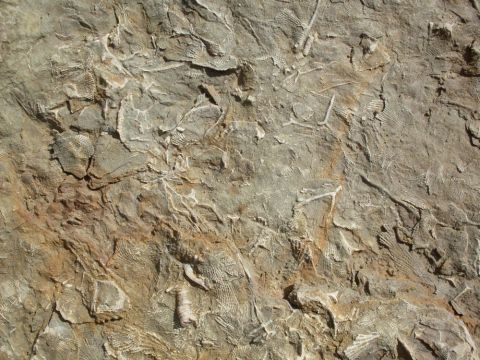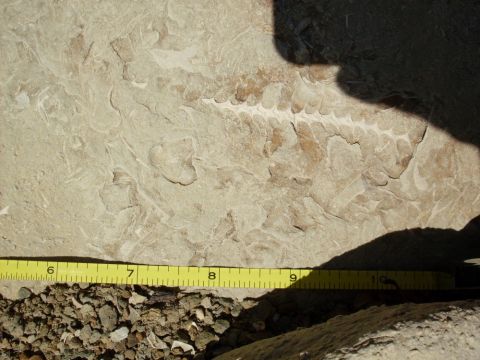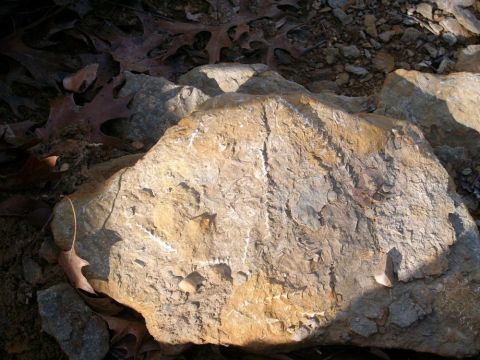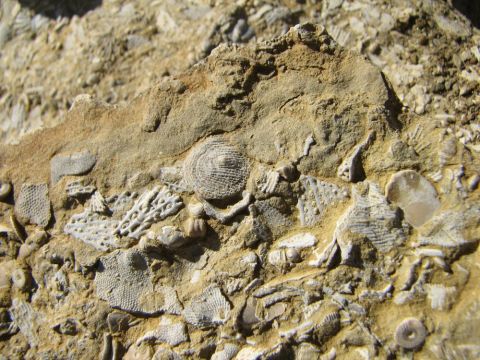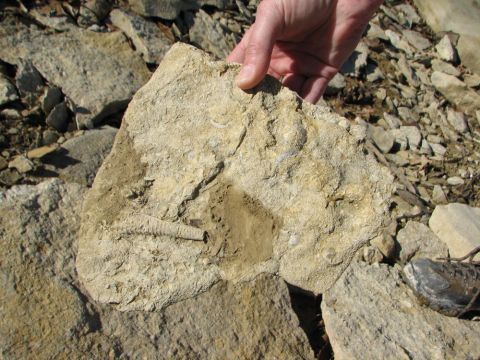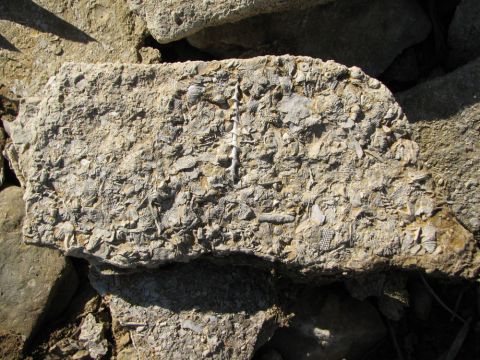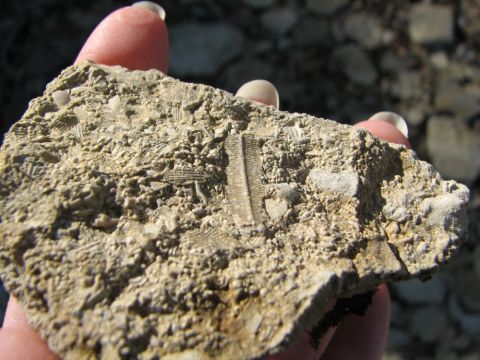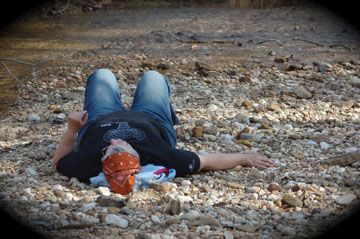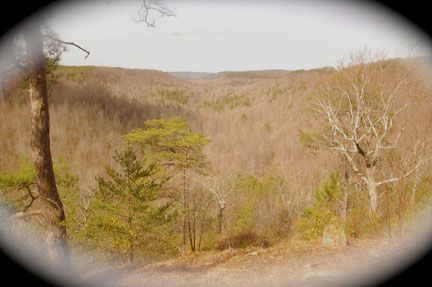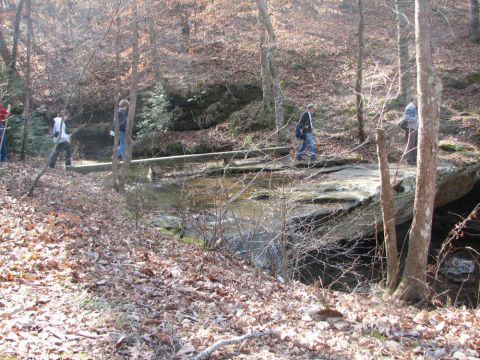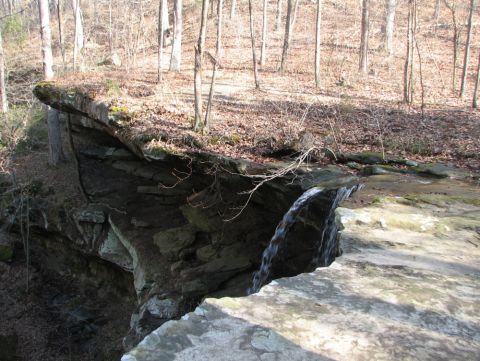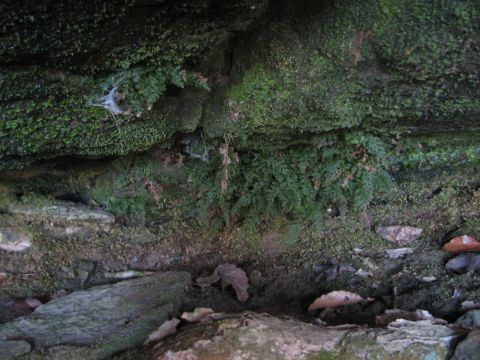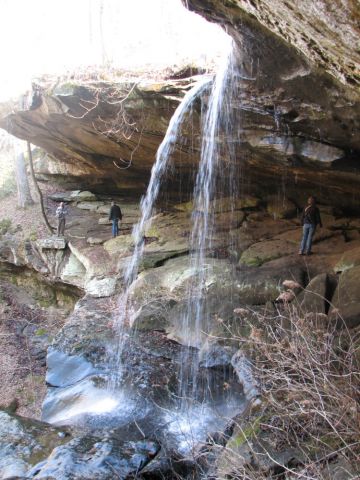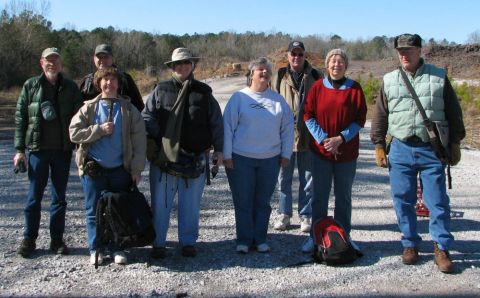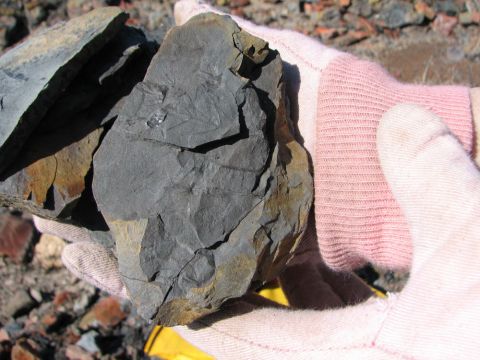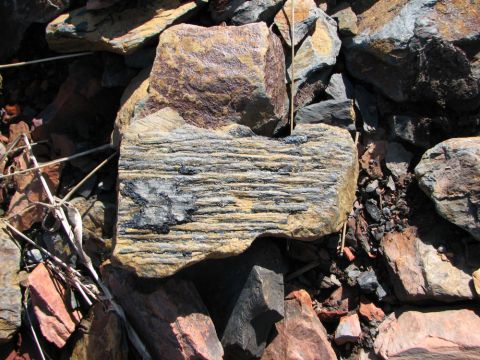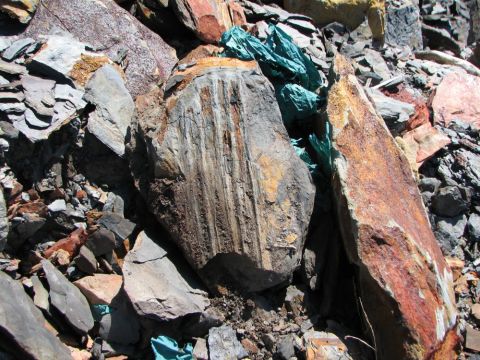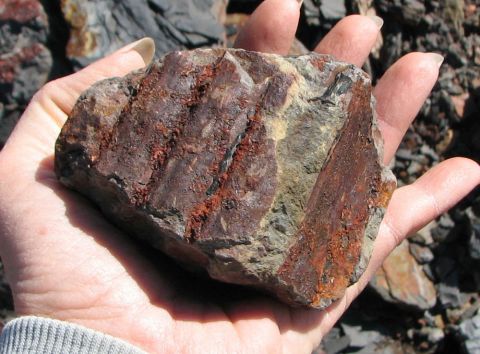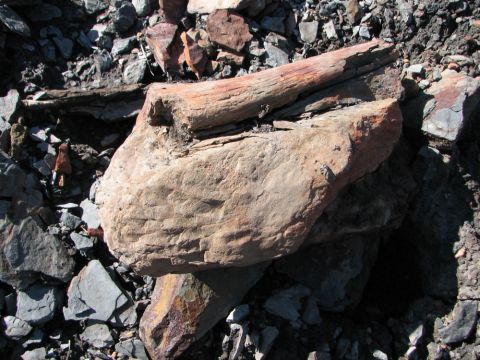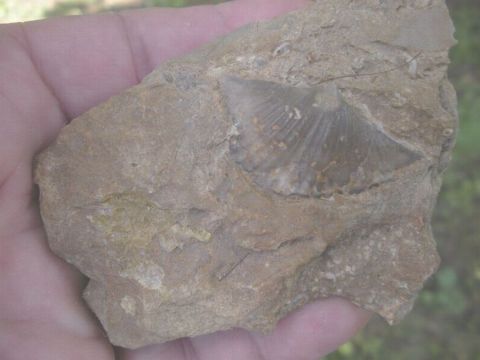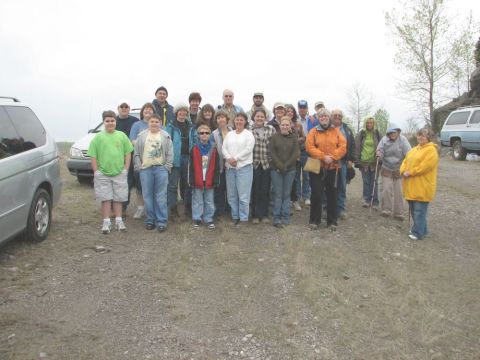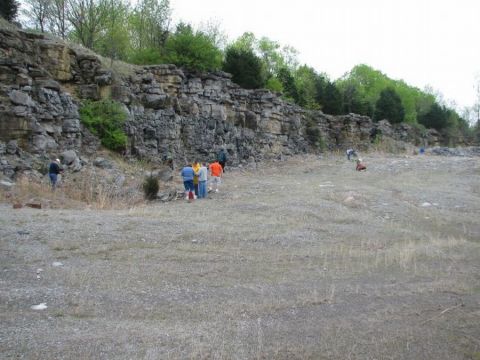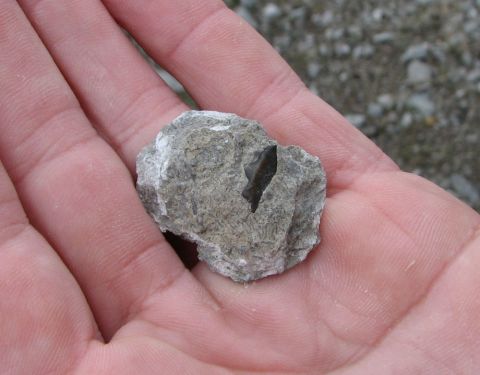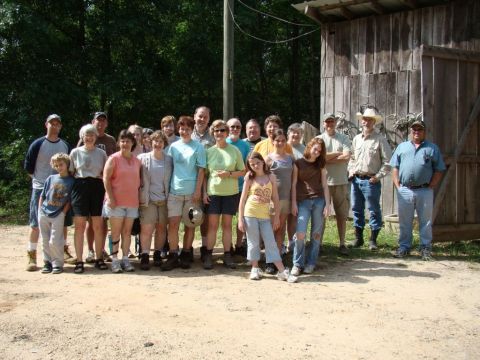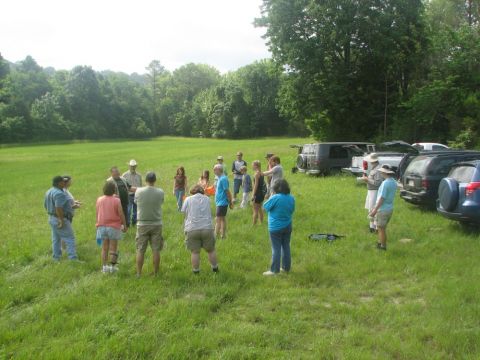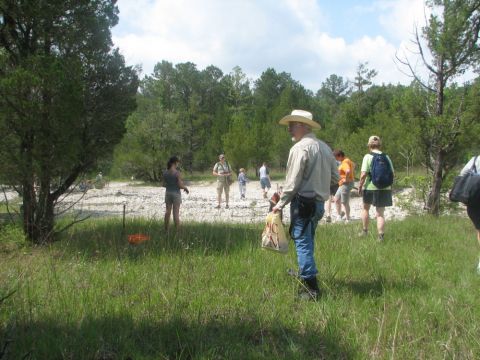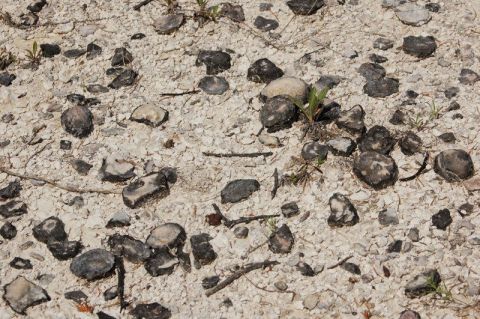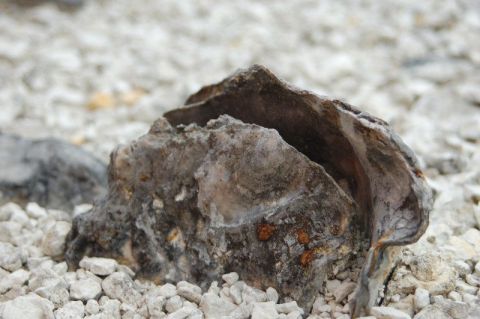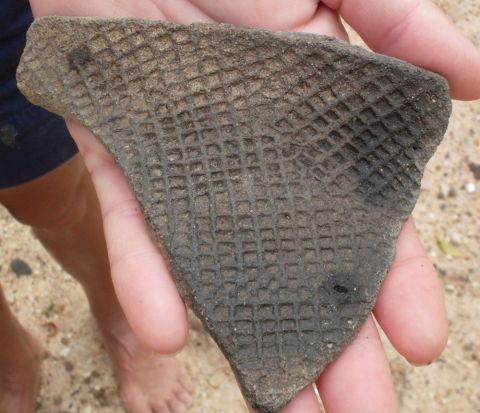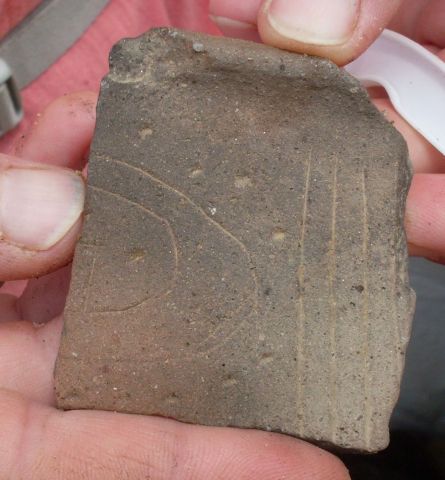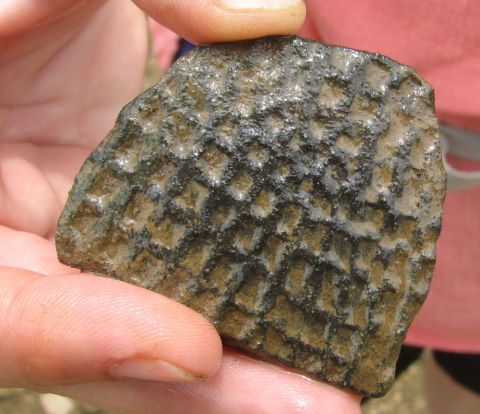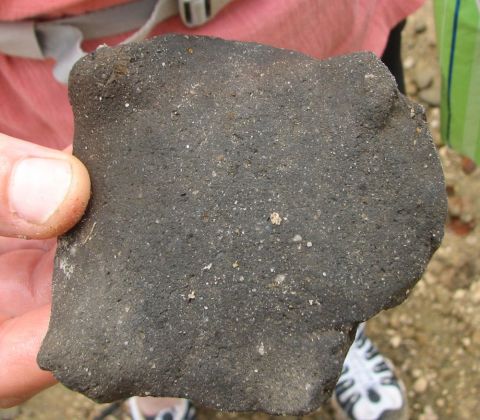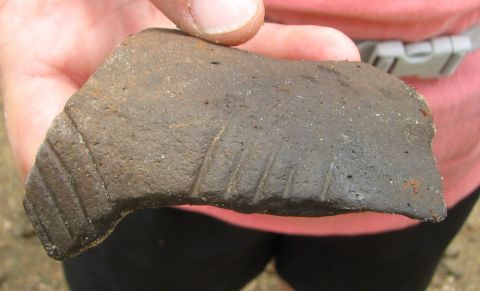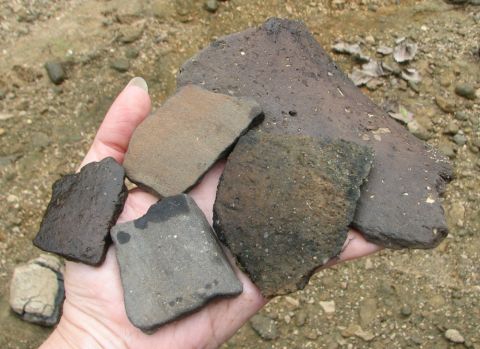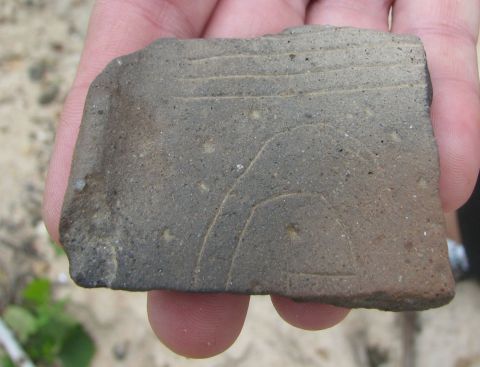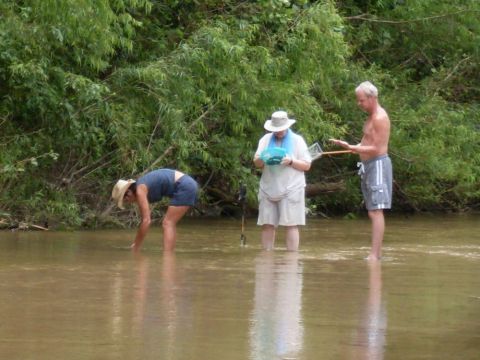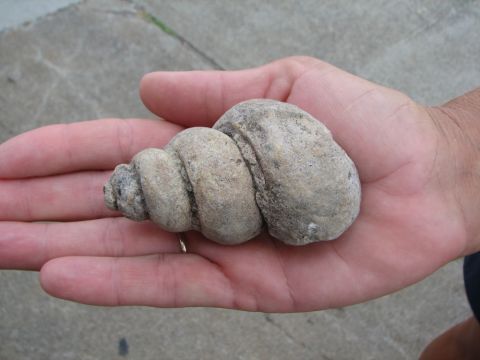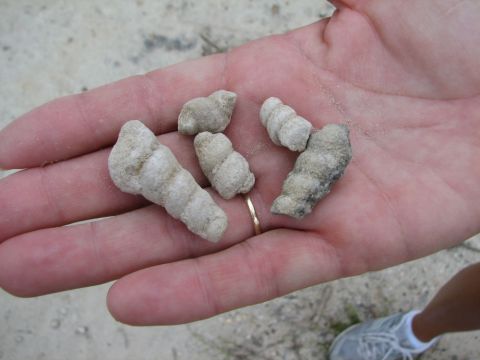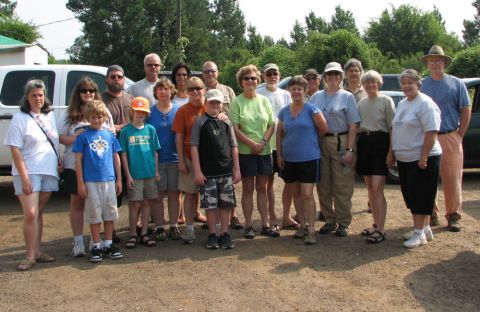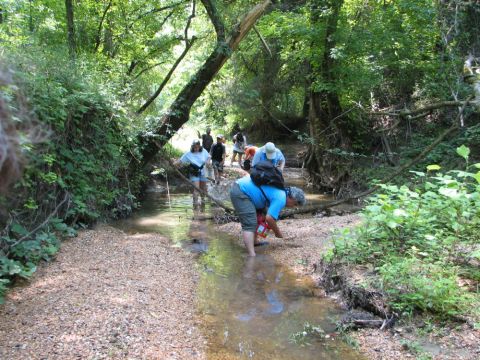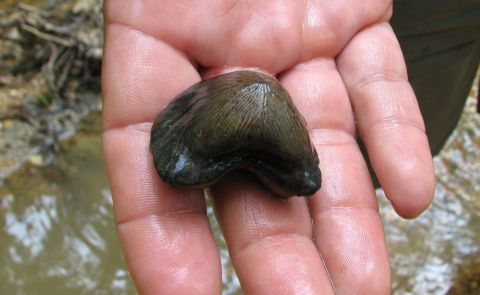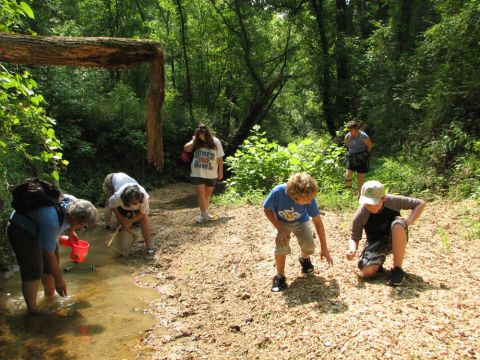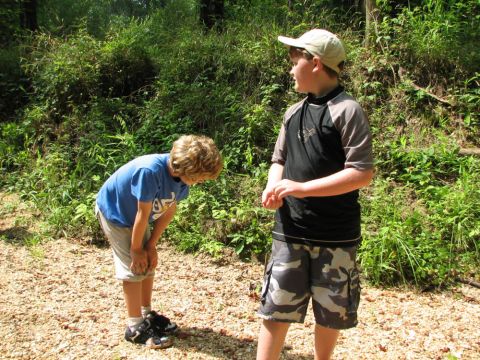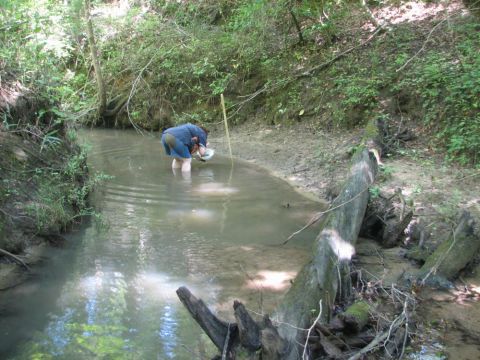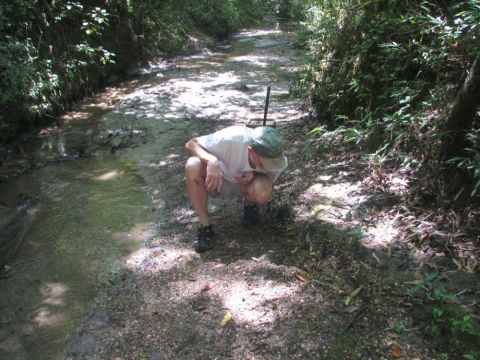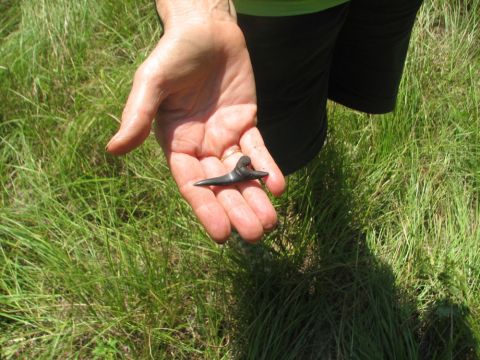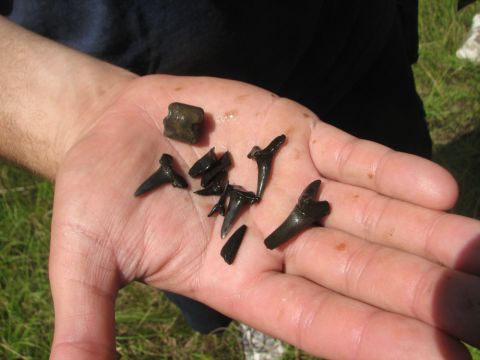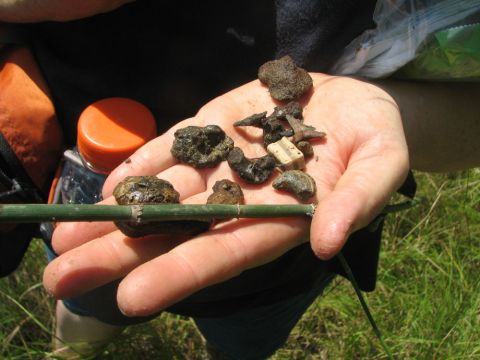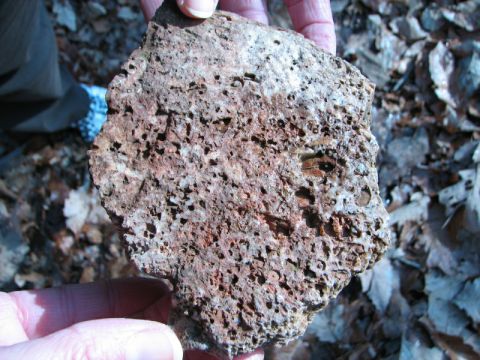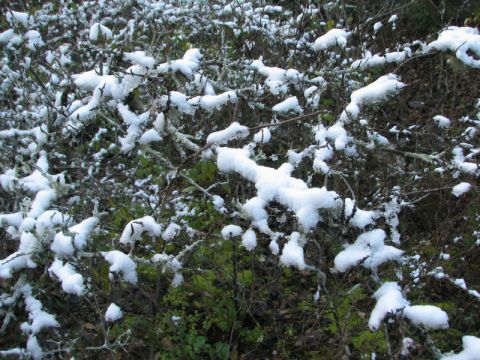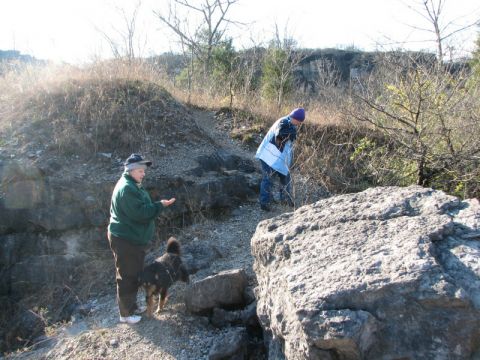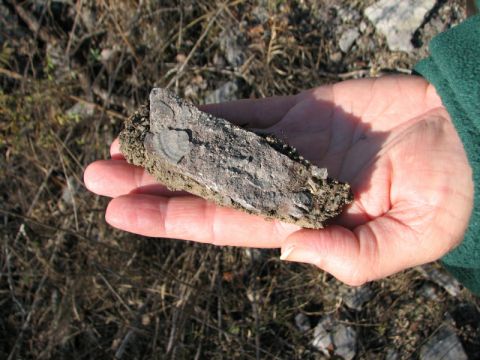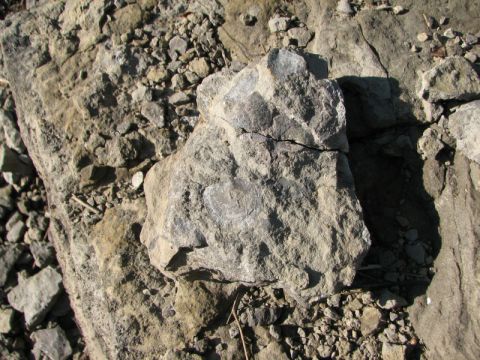2009
February 7 and 8, 2009 Mississippian Fossils, NW Alabama, various sites
BPS members gathered in NW Alabama for a full weekend field-trip February 7 and 8. We couldn't have begged, pleaded or prayed for better weather! Since we were slogging through a great deal of mud culling for Mississippian fossils, the unseasonal warmth was a treat! Lots of conglomerate "collections" were found, featuring the remains of archimedes, brachiopods and crinoids. Some blastoids were found, and Bob found a beautiful starfish on the scouting trip last week. We visited several sites, met some nice folks who were curious about what all those adults were doing, crawling around on their hands and knees etc.
Saturday night brought camping in the Cane Creek Canyon Preserve. This entire area is owned and beautifully-maintained by Jim and Fay Lacefield. They welcome guests and keep clean (and welcome) rest-areas and picnic areas featuring well-stocked little privies and fresh drinking-water. On Sunday, we were treated to a guided tour by Jim and heart-stopping rides around the trails on a six-wheeler with Fay. Makes the biggest roller-coaster you've ever been on seem tame! There are several overhanging caves in the area and Jim gave us a great overview of the tribes who made them their living-areas at various times of the year. We then went on to the creek where Jim talked about the geology of the rocks all around, how they came to be there and discussed the flora that was starting to bloom. At least one variety manages to survive the deers' grazing by appearing on the tops of some of the boulders that the animals cannot reach.
BPS owes a HUGE THANK-YOU to Jim and Fay for a fascinating day in a beautiful setting. IF you wish to visit, be sure and call ahead and check in with the Lacefields and PLEASE clean up behind yourselves, making sure that campfires are completely out and pack OUT anything you packed IN!
Sunday photos taken at Cane Creek Canyon Preserve.
Saturday photos of fossil trip are below.
Photos courtesy Claire Smith, Jaimie Hill and Vicki Lais.
February 8, 2009 - Cane Creek Canyon Preserve, Colbert Co, AL
Sunday was spent hiking in the Cane Creek Canyon Preserve. Pictures are below.
Photos courtesy Nancy Lea and Vicki Lais.
Return to the Saturday fossil field trip in Franklin County, Alabama.
February 21, 2009 - Pennsylvanian Fossils, Bibb Co, AL
Well, sometimes things happen unexpectedly. A call on Monday to the landowner to schedule a field trip for March. Well, actually he said, the site is ready to be reclaimed. Next week. Can you come this Saturday? Well . . . . . Sure we can! A hastily planned trip to Bibb County, Alabama caught many members by surprise. We came here a couple of years ago, but our collecting area was severely restricted due to ongoing construction. This time - no restrictions - we had access to the entire site. Those who could come found beautiful plant material at this old coal washing facility. Numerous specimens of lepidodendron, calamites, some delicate ferns and numerous other fossil plants were found. Afterwards a quick trip to the Cahaba River where the Cahaba Lilies bloom in May, then to a beehive oven location. Our last stop of the day was to collect graptolites.
Photos courtesy Bill Fowler and Vicki Lais
April 11, 2009 - Mississippian Fossils, Morgan Co, AL
On 11 April, BPS visited a quarry in Morgan county. After signing in and filling out all the release forms we were escorted to the dig site. The quarry contains limestone, and the fossils found were primarily from the Mississippian Period of the Paleozoic Era.
The Mississipian Period is known as the "Age of Crinoids". This period spanned approximately 360-320 million years. It was named for the exposed rocks in the Mississippian River valley near St. Louis by geologist Alexander Winchell in 1870. The quarry visited was mining limestone. Limestone is a sedimentary rock composed largely of the mineral calcite (calcium carbonate: CaCO3). Shells and other marine byproducts settle on the ocean floor and are compressed for millions of years as layer by layer of the calcite are depostited. Limestone also contains variable amounts of silica, chert, sand, silt and other impurities. It can be crystalline, clastic (composed of fragments of other rocks), granular or massive depending on the method of formation.

We had an excellent turn out. It turned a bit cold, but that didn’t dampen the spirits of the members.

After being briefed by the quarry escorts, who remained with us, we began to spread out and search for treasures. Most of the material found was in limestone rock, and some was very difficult to extract without heavy chisels and hammers.

Several Blastoids (Pentremites pyriformise and Pentremites godoni) were found by most on top of the ground in small washes. Blastoids originated in the Ordovician period and reached their greatest diversity in the Mississippian period. The picture below shows the main body or theca of the blastoids. It was protected by a series of interlocking plates made from calcium carbonate. This was attached to a stalk, which in turn was anchored to the sea floor by a holdfast. Similar to the Crinoid.

Most of the blastoids were found on the surface in small washes. Here Ron is praying to the fossil gods to show him a blastoid as everyone else had found them and he had not.

There were many occurrences of Bryozoans at the site. Several nice finds were made. Below is a picture of an Archimedes, and Fenestella Bryozoan. Fenestella bryozoa colonies, are lace-like in construction, and the individual bryozoan animals lived in microscopic tubes or pores on the lace branches. The fenestrate bryozoan colony called Archimedes lived attached to a screw-shaped support structure. Most often only the support structure is found. Bryozoans have existed for hundreds of millions of years (since the early Ordovician) and are common fossils in marine deposits. Thousands of Byrozoans species exist today all over the world.

Becky found an unusual item. James Lamb ( Paleontologist at McWane Science Center in Birmingham, Alabama) was called over to help identify it. The find turned out to be a nice Petalodus (Petalodontidae (Petalodontiformes) sharks tooth. It took over an hour and a half to extract it from the limestone it was embedded in. Becky donated the specimen to the McWane Center museum.

Here's a closer look at the Petalodus tooth. Petalodus sharks were estimated to reach a length of about 2 meters. Their basic diet consisted of sponges and other invertebrates.

A few Brachiopods were also found. Brachiopods are two valved animals, similar to the bivalves today.
Most Brachiopods were attached to the bottom by means of a fleshy stalk and were not free swimming like many of the bivalves today. The Brachiopod in this picture (spiriferina transversa) was 4 cm across.

Not just fossils were found. Here's one of many calcite crystal clusters that were also found. Incidently these crystals are simply the crystalline form of limestone (CaCo3).

Many Crinoid and Blastoid stem parts were found on the surface of the collecting area.

Several specimens of horn coral were also found. Horn corals are from the extinct order of corals called Rugosa. Rugosa means wrinkled. The outside of these corals have a wrinkled appearance. Horn Coral grows in a long cone shape like a bull’s horn. The fossil is the skeleton of the coral animal or polyp. The animal lived at the top of the cone. They had many tentacles sticking out to gather food. The tentacles gave the horn coral a flower like appearance.


Several outcroppings of other coral were also found. The species of coral has not yet been identified.

Leisa found a small trilobite. The species is not known at this time. Tiribites are found in many other counties in Alabama. In the geologic time scale, they came to dominate the seas around 540 million years ago and became extinct around 245 million years ago.

Here Martha shows her prize of a limestone slab containing numerous fossils.

Here's a closeup of the limestone slab containing a collection of many different fossils including crinoiod, blastoid, stem parts, archimedes and various other bryozoans.

Don and Jamie discuss their finds near where many blastoids had been picked up.

Pictures courtesy Vicki Lais and Ron Beerman
April 11, 2009 - Mississippian Fossils, Morgan Co, AL, Part 2
Part 2 - Trip Photos (this page)
This Mississippian limestone quarry yielded a variety of fossils, including crinoids, blastoids, a very ancient shark tooth by the name Petalodus, archimedes, bryozoans, brachiopods, Rugosa and other corals, and even part of a trilobite.
(Photos courtesy Ron Beerman, Becky Guthrie, and Vicki Lais)
May 16, 2009 - Cretaceous Fossils, Sumter County, AL
Old hands as well as new joined up early on Saturday morning for a trip to some great Cretaceous gully sites in West Alabama. Dr. John Hall and Dr. Andy Rindsberg, both from the University of West Alabama, led us down chalk roads (more later on the chalk roads!) and through the woods to the bottom of the ancient ocean. The landscape looked like the remains of an ancient clam-bake! Literally MILLIONS of fossilized shells including exogyra, various clams, shark and sawfish teeth, crab claws, oyster shells, echinoid spines, and at least one small shark vertebra. One of our teen-aged guests, Megan, discovered a large Rudist clam. This was only her second trip with BPS and her find was sufficiently rare from this location that Dr. Hall claimed it for the nascent Black Belt Museum in Livingston. Her name will remain with it and she will get a letter of recognition.
Many who drove up from Birmingham were watching the weather, and at least one member called to see if the trip had been cancelled. Cancelled??? Hey, this is BPS, guys! But later in the day rumbling could be heard and the clouds looked angry. The landowner sent word that the rain was about an hour away, so we started moseying back to the cars. Oops, not fast enough, we were drenched by the time we made it back to the field. So. How many people remember James Lamb telling us over and over - GET OUT OF THE GULLIES BEFORE IT STARTS RAINING??? Let's see. . . chalk . . clay . . water . . slick . . stuck in mud. Yeah, right. At least 3 vehicles had to be pushed out, um, slid out, perhaps? Needless to say, we were all pumped up with adrenaline by the time we made it back up the long winding road to the top of the hill! An exciting trip we will be discussing for years to come!
Edited by Vicki Lais
Pictures courtesy Nancy Lea, Larry Herr, Vicki Lais
-
Here's the whole gang, ready for a day of collecting. We have to drive quite a ways through the woods.
-
We've arrived at the field next to the gullies, where Dr. John Hall gives us an overview of the ecology and geology of the area. This area is being transformed into prairie with careful culling and burning. He also explains collecting techniques to follow so fragile fossils aren't damaged.
-
Our first sighting of the gullies. BPS has never visited this set of gullies, and they have rarely been collected, so we are anxious to start searching.
-
As many people know, BPS got its beginning with the Red Mountain Museum in 1984, where Gorden Bell, James Lamb and Scott Brande trained their first group of amateurs on how to assist professional paleontologists in the field. Larry joined us at the meeting location, modeling an ancient Leaping Lizards T-shirt from the old Red Mountain Museum. Unfortunately, he had to leave early and missed all the fun.
-
In many areas, the ground is covered with large shells.
-
Complete exogyra in place, both halves.
-
Hundreds of shells on the gully floor.
-
View towards the far end of the first gully where most of the shark teeth and sawfish teeth were found. Where is everyone? They all scattered to the many gullies in the area, and so most did not get photos taken.
Pages
June 13-14, 2009 - Artifacts, Butler Co, AL
Since many BPS club members are interested in both Paleontology and Archeology, it seemed important to find out a little bit about the culture which might have made the pottery chards which many found in the creek on the June 2009 BPS field trip.
My first thoughts were that it might have been the Creeks. Actually they originally called themselves the Isti or Istichata, but began to identify themselves as the Muskogee soon after Europeans arrived. Early settlers and traders called them Creeks after the Ocmulgee Creek in Georgia. When the first Spanish explorers came into this area in the early 1500's, The Muskogee were more of a loose confederation of small tribes, living in small villages along lakes and rivers. There are still Muskogee living in the area today.
While researching the information available on these Indians, a friend mentioned an archeologist by the name of Ned Jenkins near Wetumpka, Alabama. He is extremely knowledgeable about Alabama Indians. I decided to send a couple pictures of the pottery chards found, and also my write up on the Muskogee Indians.
Imagine my surprise when he said that the chards came from what archeologists call the Weeden Island Culture which existed between 800 – 1100 A.D. This pre-dates the Muskogee ! So let’s travel back a little bit in time around where the pottery chards were found. Perhaps 1300 years ago. It is sometimes referred to as the Woodland Period of Pre-history. The people of the Weeden Island culture had a broad-based economy that included hunting, fishing, gathering, and, probably, gardening.
There is growing evidence that they cultivated such native crops as sunflower, gourds, marsh elder, and knotweed, and possibly non-native plants including corn and beans. During the later part of the woodland period there is evidence of bow and arrow technology, and arrowheads used for hunting have been found. Not too long ago in Pinellas County, Florida, a 39 foot pine canoe dating back to approximately 1100 years ago was found, indicating these Indians had those skills also.
Late Weeden Island culture made complicated, stamped pottery, characterized by a design impressed on the surface of unfired pots with a wooden or clay paddle.
This culture eventually became part of the Mississippian culture which is where the Muskogee originated.
More about the fossils found on the trip.
--Photos courtesy Claire Smith and Vicki Lais
June 13-14, 2009 - Cretaceous and Tertiary Fossils, Butler Co, AL
This month the group traveled to Butler County, Alabama, to a sandy creek which runs through early Tertiary and late Cretaceous material. The weather was overcast on Saturday, making collecting very pleasant. A number of members camped out for the weekend. Sunday the sun was out, and it made us grateful for the cloud cover on Saturday!
The sandy beaches and gravel areas yielded up shark teeth, ray teeth, some nautiloid sections, and recent mammal material which was sometimes as fasinating as the fossils.
We had quite a few young people on the trip who enjoyed both the fossil collecting and swimming, splashing and running in the shallow creek. There is an area of soft clay, and some enterprising young men fashioned bowls from it.
More about the artifacts found on the trip.
--Photos courtesy Claire Smith and Vicki Lais.
-
The whole group, except for one young lady who didn't want her picture taken.
-
Screening for fossils in the shallow creek.
-
Making ones way up the creek took a very long time. First you have to play in the water, feel the sand between your toes. Then you have to stop at every gravel bar and see what's there. It takes most people hours to get less than 1/4 mile.
-
Nancy neck deep in a swimming hole.
-
Hanging out on the large sandy beach. This is like a crossroads, everyone passes this way, or returns here to rest.
-
Everyone set up for enjoying this wonderful creek in their own way.
-
This nice gastropod was found at this site several years ago, and was brought to the trip to display.
-
Several small turritella.
Pages
July 11, 2009 - Cretaceous Fossils, Greene Co, AL
BPS members and guests headed down to Greene county, Alabama for our July trip. This site is a creek covered with pea gravel - making screening for shark teeth and other fossils quite difficult. However, most found it fairly easy to spot the fossils lying on top of the gravel. Numerous shark teeth were found, a couple of mosasaur teeth, several ptychodus teeth, a gar vertebra and tooth, crocodilian bone, clams, oysters, and bryozoan. Vicki found a tooth so tiny (about 1/8 inch), that when she put it on her finger to get a closeup, it rolled off. The next 45 minutes was spent digging through the gravel in an ever widening circle, trying to find the tiny tooth again. As we finally gave up, she rolled the gravel around again, and there it was! It went in a medicine bottle for safekeeping, until a photo could be taken in a "safe" location! It has been identified as a gar tooth, which is more rare than mosasaur teeth in this area.
--Photos courtesy Vicki Lais
August 29, 2009 - Late Cretaceous, Perry County, Alabama
This month BPS members went to Perry County, in south Alabama, and collected in a creek where it has been said, this is the furtherest north that cretaceous material is found. It has been a while since we collected at this site, and kudzu and other grassy plants had grown over the road, making it a challenge to find our way to the site this time.
As Vicki searched for the elusive "easy way down" for over an hour, the others slid down the steep embankments to reach the fossils found in the creek. The fossils consisted mostly of various varieties of shark teeth. A few mosasaur teeth, gastropods and ammonite parts were also found. One of our visitors even found an arrowhead.
Photos courtesy Vicki Lais
December 5, 2009 - Mississippian & Ordovician Fossils, Jefferson Co, AL
A hastily put together field trip ended up being on a snowy day, and most members decided to stay snug in their warm homes. Three of us were ready to brave the snow, cold, and wind, so we headed to Ruffner Mountain, to enjoy the old quarry, and check on the rock we etched many years ago so visitors could see the range of fossils in the limestone.

